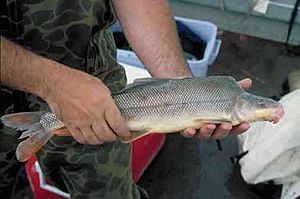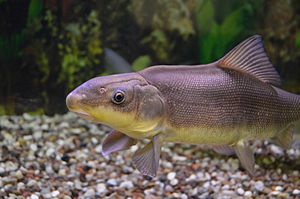Razorback sucker facts for kids
Quick facts for kids Razorback sucker |
|
|---|---|
 |
|
| Conservation status | |
| Scientific classification | |
| Genus: |
Xyrauchen
|
| Species: |
texanus
|
The razorback sucker (Xyrauchen texanus) is a special type of suckerfish. You can find it in rivers and lakes in the southwestern United States. This fish can grow up to 91 centimeters (about 3 feet) long! It's easy to spot because of a unique bump, like a keel, on its back between its head and dorsal fin.
This fish used to live all over the Colorado River Basin. However, things like fishing, building dams, and losing its natural home have caused its numbers to drop a lot. Now, it mainly lives in the Colorado River above the Grand Canyon. You can also find it in four lakes: Lake Mead, Lake Mohave, Lake Havasu, and Lake Powell.
Razorback suckers usually travel from deep water to special places to lay their eggs. Scientists are still studying their habits and where they breed. Since 1991, this fish has been protected by the government. The International Union for the Conservation of Nature says it is "critically endangered". This means it's at a very high risk of disappearing forever. But there's good news! In 2012 and 2013, some razorback suckers were seen below the Grand Canyon, which is a sign of hope.
Contents
What Does a Razorback Sucker Look Like?
The most noticeable thing about the razorback sucker is the sharp-edged bump on its back. This bump is located between its head and dorsal fin. This unique feature is why it's called a "razorback" sucker. Some people also call it a "humpback sucker."
These fish can grow quite large. They can reach lengths of up to 91 centimeters (3 feet). They can also weigh up to 6 kilograms (about 13 pounds). A common length for these fish is around 50 centimeters (about 1.6 feet). The top part of the fish is usually an olive green to brown-black color. This color fades to a lighter yellow on its belly. Adult razorback suckers are easy to tell apart from other suckers because of this special bump on their back.
Where Do Razorback Suckers Live?
Originally, razorback suckers lived in many medium and large rivers of the Colorado River Basin. But their home range has become much smaller. Now, they mostly live in the river above the Grand Canyon. They also live in Lake Mead, Lake Mohave, and Lake Havasu in the lower part of the river. The main reason for this decline is that they have lost their natural living spaces.
The state of California declared the razorback sucker an endangered species in 1974. The United States government followed in 1991. There's a big group of over 3,000 fish in Lake Mohave. This group was created by a program that used baby fish, called fry, that were born naturally in the lake. Also, programs have released fish raised in hatcheries into Lake Havasu. They have also been released into the Colorado River below Parker Dam and the Verde River.
In 2012 and again in 2013, razorback suckers were found in the lower Grand Canyon. These were the first times they had been seen in the Grand Canyon National Park since the 1990s. In March 2014, scientists released nine tagged adult razorback suckers into the Colorado River. This was done below the Lava Falls. By tracking these fish, biologists hope to find out where other spawning fish are. They also want to learn how the fish move and use their habitat.
In spring 2014, a new search for fish reproduction in Grand Canyon National Park happened. This search led to the first discovery of baby fish (larvae) in several decades. Scientists found spawning razorbacks at nine out of 47 sites they checked.
Razorback Sucker Life Cycle and Habits
Razorback suckers can live for a long time. Some older fish have been estimated to be over 40 years old! Both male and female fish become ready to have babies when they are four years old. They lay their eggs in late winter or spring. During this time, groups of razorbacks settle on the riverbed. They then release their eggs and sperm. The eggs are sticky and attach to the spaces between the gravel on the river bottom.
One female fish can have two to twelve males around her. The female will lay eggs many times with different males. How well the eggs hatch depends on the water temperature. If the water is colder than 10 degrees Celsius (50 degrees Fahrenheit), all the eggs will die.
Razorback suckers live in many different areas. These include main river channels and calmer backwaters of medium and large streams. They prefer to live over sandy, muddy, or gravelly bottoms. Razorbacks eat algae, insect larvae, tiny water creatures called plankton, and decaying plant and animal matter.
Their eyes can see parts of UV light. This is especially true for the part of their eye that sees light from below. Razorbacks spend most of their lives in deep water where UV light can't reach. But they move into shallow areas for breeding. In the shallow water, males claim a breeding territory. They hover near the riverbed. When another male enters the breeding area, the defending male rolls his eyes downward. This shows the top third of his eye, creating a flash of reflected sunlight. The strongest part of this flash is in the UV light spectrum. The male swimming above can see this flash from below and will swim away from it. These eye flashes are not visible from far away underwater. This means they can signal to other males without attracting predators. Female fish do not react to these eye flashes.
Protecting the Razorback Sucker
The razorback sucker used to be very common in the Gila River watershed areas of Arizona. But commercial fishing and the building of dams greatly reduced their numbers. The fish couldn't breed well because the water in the reservoirs was too cold. Also, dams blocked their movement into smaller channels.
Now, the razorback sucker is listed by the U.S. government (since October 23, 1991) as an endangered species. This means there are rules to protect their important living areas. Efforts to protect them are happening all over the Upper and Lower Colorado River Basins. The largest and most diverse group of razorback suckers lives in Lake Mohave, which is on the border of Arizona and Nevada.
See also
 In Spanish: Xyrauchen texanus para niños
In Spanish: Xyrauchen texanus para niños



